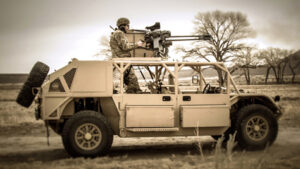Big Company, Small Vehicle? General Dynamics Offers Flyer For ULCV
Posted on
Can the big guys go fast? In the race to build the Army’s new Ultra-Light Combat Vehicle, General Dynamics is the second biggest competitor, after Boeing, now that aerospace giant Lockheed Martin has dropped out altogether. A traditional defense contractor that builds everything from Army tanks to Navy submarines, GD faces outsiders like commercial offroad vehicles maker Polaris and special ops shop Vyper Adamas, who are proud of their innovation and nimbleness. As the Army seeks a new, nimbler way of doing business, how can the big guys keep up?
First of all, by not being so big. “GD-OTS [Ordnance & Tactical Systems] is a very nimble, very reactive company,” said Sean Ridley, a senior manager on GD’s Flyer vehicle program. “We’re a small division within Combat Systems, and I think we’ve got a proven track record of being responsive and listening to our customer.”
Consider the last competition GD’s Flyer won, the Special Operations Command Ground Mobility Vehicle (GMV). Losing bidders AM General and Navistar promptly filed protests and a lawsuit. But despite “about a year and a half delay,” Ridley told me, GD has helped keep the program on schedule, and the Milestone C decision to move into production will occur on time in June.

General Dynamics Flyer-72
GD-OTS works on everything from artillery shells to Smith & Wesson handguns, but on the Flyer, it’s partnered with a smaller firm that just does vehicles, Flyer Defense. (Flyer Defense in turn is part of Marvin Group, which mainly makes aircraft components) “We were already in the light tactical vehicle market, [but] Flyer Defense had a vehicle that was very interesting. It’s state of the art,” said Ridley.
In return for Flyer’s automotive expertise, Ridley went on, “we bring to the table program management, manufacturing, integrated logistics support. [We’re] a big brother to a smaller company.”
The team’s original Flyer-60 won SOCOM’s Internally Transportable Vehicle competition in 2013. The ITV had to fit inside a CV-22 Osprey (hence “internally transportable”), which meant it had to be just 60 inches wide (hence “Flyer-60”). Last year, it won SOCOM’s GMV competition with the larger Flyer-72.
“Both vehicles share the same suspension, they share the same drive train,” Ridley said. The 72’s just bigger — and incidentally, faster. It can go a maximum of 100 miles per hour compared to the 75 mph for Flyer-60.
When configured as the SOCOM GMV, the Flyer-72 is too heavy for the Army ULCV, nor does it have room for the nine soldiers the Army requires. That’s a simple fix, said Ridley. SOCOM wants much more communications gear and armor than does the Army, and if you don’t add all that kit, the Flyer handily accommodates nine fully loaded infantrymen while still staying under the required 4,500 lbs.
Conversely, if you want to uparmor the Flyer and add lots of specialized kit, Ridley said, it can function just fine as an 11,200 pound vehicle. In fact, General Dynamics plans to offer a configuration of the Flyer for the Army’s Light Reconnaissance Vehicle (LRV), ULCV’s big brother, which needs to carry armor, six scouts, and a 30mm gun.
All these vehicles would come off the same assembly line. The light ULCV, the heavy GMV, and the possibly-even-heavier LRV would all be built at Anniston, Ala. “We’ve got a base vehicle that we mount several kits to, [and] it doesn’t take a great deal of effort to reconfigure the vehicle for either GMV 1.1, ULCV, or LRV,” Ridley told me. “You’re just bolting on different kits to that vehicle.”
Buying lots of one vehicle that can be modified for different missions is much more attractive to the military than buying several different vehicles, each to do a different job. Logisticians like only having to keep a single set of spare parts on hand, while budgeteers like the cost savings. Efficiencies of scale, incidentally, are something big companies tend to do best.
Correction: The original version of this article referred to General Dynamics as the largest company left in the ULCV competition — I’d quite forgotten about Boeing’s beautifully named Phantom Badger.
Subscribe to our newsletter
Promotions, new products and sales. Directly to your inbox.
